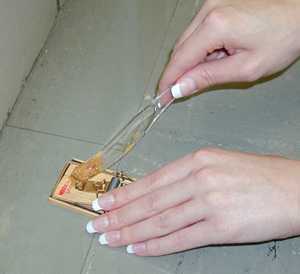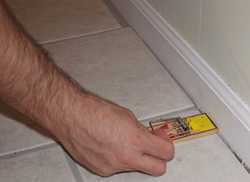Trap Up!
Trap rodents around the home to help reduce the rodent population

Baiting a snap trap with peanut butter.
Choose an appropriate snap trap. Traps for catching mice are different from those for catching rats. Carefully read the instructions before setting the trap.
When setting the trap, place a small amount of peanut butter (approximately the size of a pea) on the bait pan of the snap trap. Position the bait end of the trap next to the wall so it forms a "T" with the wall. Rodents prefer to run next to walls or other objects for safety and do not like being out in the open.
In attics, basements, and crawlspaces and other areas that do not have regular human traffic, set traps in any area where there is evidence of frequent rodent activity. Some rodents, particularly rats, are very cautious and several days may pass before they approach the traps. Other rodents, such as house mice and deer mice, are less cautious and may be trapped more quickly.

Positioning a snap trap so it forms a "T" with the wall.
We do not recommend using glue traps or live traps. These traps can scare mice that are caught live and cause them to urinate. Since their urine may contain germs, this may increase your risk of being exposed to diseases.
Also place traps in outbuildings and in areas that might likely serve as rodent shelters. Natural rodent predators, such as non-poisonous snakes, owls, and hawks, may also help control and reduce the number of rodents outside the home.
If you trap inside your home, but do not seal up rodent entry holes, new rodents will enter the dwelling. For information on how to seal up holes inside and outside the home, please see the Seal Up! page.
- Page last reviewed: July 29, 2010
- Page last updated: July 29, 2010
- Content source:


 ShareCompartir
ShareCompartir